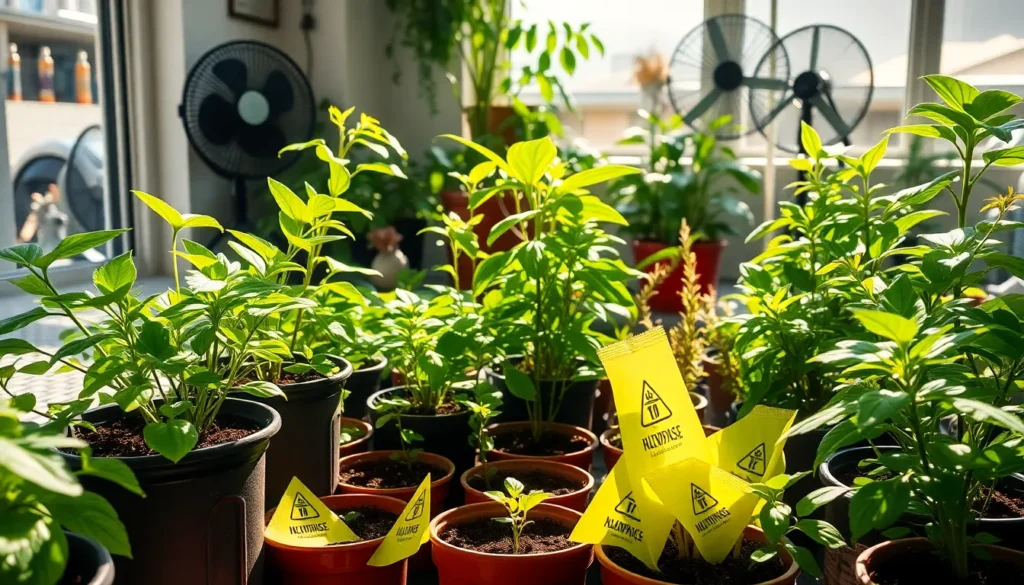We’ve all been there – you’re enjoying your beautiful houseplants when suddenly you notice tiny flying insects hovering around the soil. These annoying little creatures are fungus gnats and they’re more than just a nuisance. They can actually damage your plants’ roots and create an unpleasant living environment.
Fungus gnats thrive in moist potting soil and multiply quickly if left unchecked. The good news? We can eliminate these pests using simple natural methods and preventive measures that won’t harm your plants or your family.
Whether you’re dealing with a minor gnat problem or a full-blown infestation we’ll show you exactly how to reclaim your indoor garden. From immediate answers that work within days to long-term prevention strategies these proven techniques will keep your houseplants healthy and your home gnat-free.
Identify the Type of Gnats Infesting Your House Plants
Before we tackle the problem, we need to correctly identify which type of tiny flying pest is bothering our beloved houseplants.
Fungus Gnats vs. Fruit Flies
Fungus gnats are the most common culprits in our indoor plant collections. These small dark flies measure about 1/8 inch long and have long legs with clear or grayish wings. We’ll typically spot them hovering around the soil surface of our potted plants, especially those with consistently moist growing medium.
Fruit flies look quite different from their plant loving cousins. These pests appear more yellowish or tan in color and have a stockier build with red eyes. We’ll usually find them near overripe fruit, garbage disposals, or drains rather than clustering around our plant soil.
Key differences help us distinguish between these two pests:
| Feature | Fungus Gnats | Fruit Flies |
|---|---|---|
| Size | 1/8 inch long | 1/8 inch long |
| Color | Dark gray or black | Yellow to tan |
| Body shape | Slender with long legs | Stockier build |
| Eye color | Dark | Bright red |
| Preferred location | Plant soil surface | Fruit and organic matter |
| Flight pattern | Weak, erratic | Strong, direct |
Signs of Gnat Infestation in Indoor Plants
Adult gnats flying around plants represent the most obvious indicator of an infestation. We’ll notice these tiny insects taking off from the soil when we water our plants or move the pots.
Larvae in the soil appear as small translucent worms with black heads, measuring about 1/4 inch long. We can spot them by gently disturbing the top inch of potting mix with our finger.
Plant health decline becomes evident as gnat larvae feed on organic matter and roots in our soil. We might observe yellowing leaves, stunted growth, or an overall weakening of our plants’ vitality.
Sticky yellow traps filled with gnats confirm our suspicions when we place these monitoring tools near affected plants. We’ll typically catch dozens of adult gnats within a few days of installation.
Fungal growth on soil surface often accompanies gnat infestations since both thrive in overly moist conditions. We may notice white or gray fuzzy patches developing on top of our potting mix.
Remove Adult Gnats Using Sticky Traps
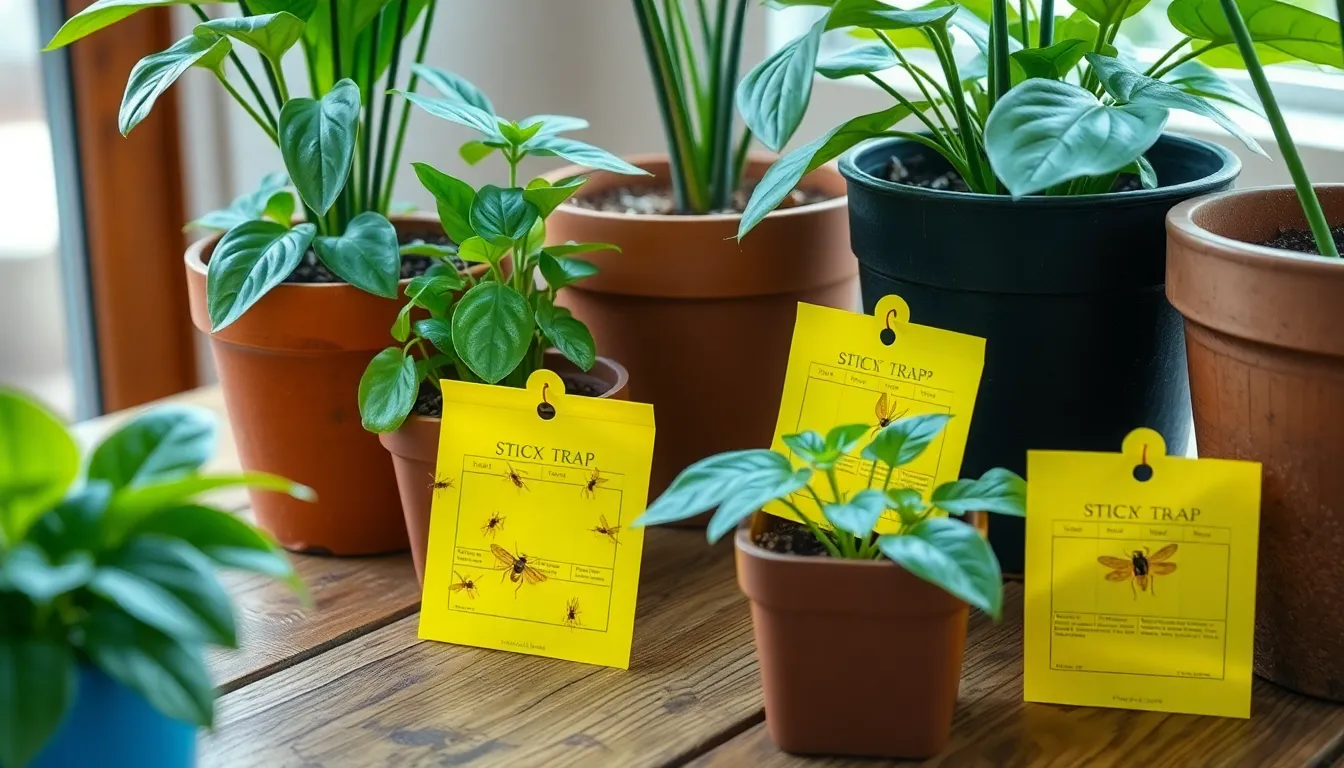
Sticky traps provide one of the most effective methods for capturing adult gnats before they can reproduce. Yellow sticky traps work exceptionally well because their bright color attracts fungus gnats, causing them to land on the adhesive surface where they become permanently trapped.
Yellow Sticky Trap Placement Strategy
Position traps directly on the soil surface where adult gnats emerge and begin their flight patterns. We recommend placing multiple traps around heavily infested plants to maximize capture rates and significantly reduce adult populations.
Monitor trap effectiveness by checking them every few days to assess gnat activity levels. Replace traps approximately every two weeks or when they become full of captured insects to maintain optimal stickiness.
Strategic placement near plant bases disrupts the gnat life cycle by eliminating adults before they can lay eggs in moist soil. This targeted approach helps break the reproduction cycle that keeps infestations thriving in our houseplants.
DIY Sticky Trap Alternatives
Create homemade yellow traps using index cards or cardboard coated with petroleum jelly for a budget friendly solution. Cut the material into small rectangles and place them on wooden stakes inserted into the soil.
Apply double sided tape to bright yellow paper or plastic surfaces as another effective DIY option. Position these makeshift traps at soil level where gnats typically hover and land.
Consider vinegar traps as a supplementary method, though they’re less effective than sticky alternatives for capturing large numbers of adult gnats. Fill small containers with apple cider vinegar and place them near affected plants to attract and drown flying adults.
Combine sticky traps with soil treatments such as mosquito dunks or hydrogen peroxide drenches for comprehensive gnat control that targets both adults and larvae simultaneously.
Eliminate Gnat Larvae in Potting Soil
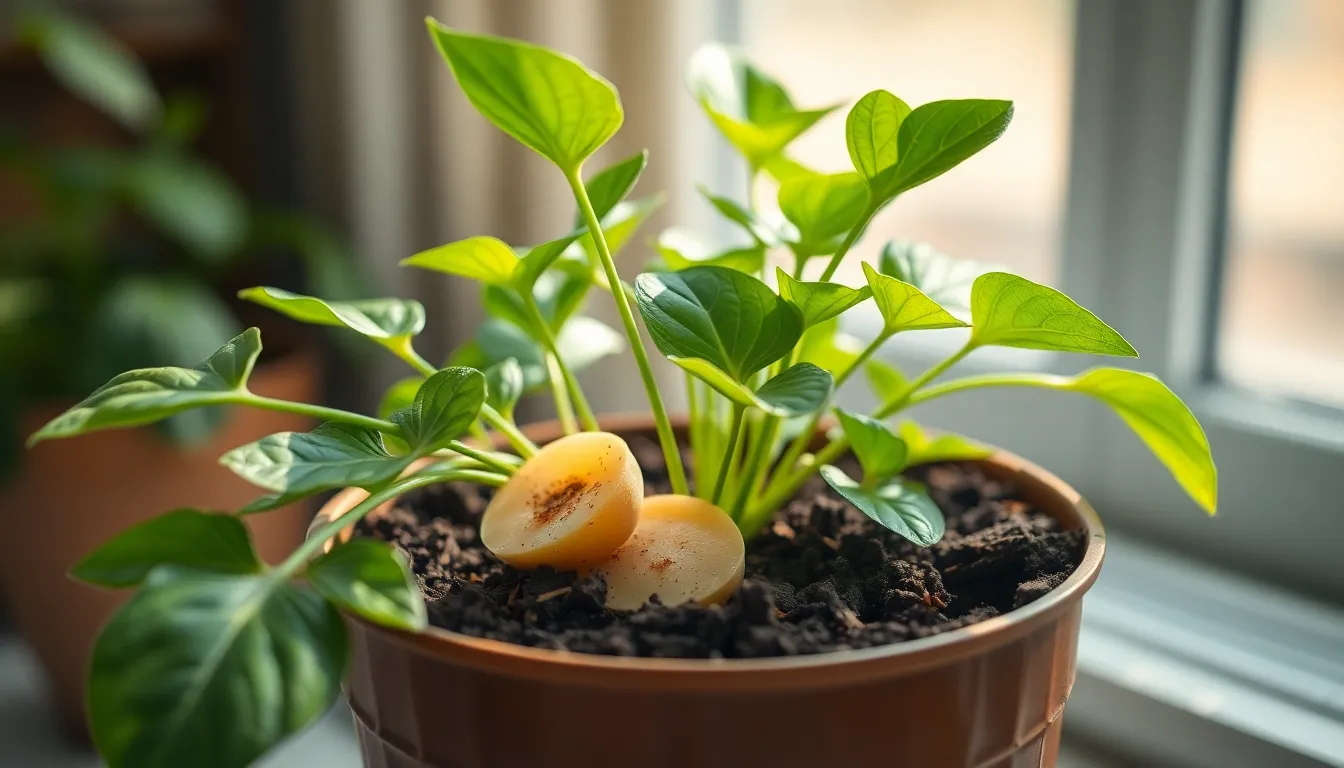
The larvae stage is where we need to focus our most intensive efforts since these pests develop in the top 5 cm of moist potting soil. Targeting the soil environment directly disrupts their breeding cycle and prevents future generations.
Drying Out Soil Between Waterings
Overwatering creates the perfect breeding ground for fungus gnat larvae. We recommend allowing the soil to dry out completely between waterings, checking that the top 2 cm feels dry to the touch. This method makes the environment inhospitable to both larvae and eggs since these pests require consistently moist conditions to survive.
Turning the topsoil gently with a fork exposes hidden larvae to drying air, which naturally reduces their population. Most fungus gnat larvae concentrate in the upper soil layers where they feed on decaying organic matter and fungi.
Potato Slice Trap Method
Raw potato slices work as an effective larvae detection and reduction tool. We place inch wide potato pieces just beneath the soil surface for 4 to 8 hours, then remove and discard them along with any trapped larvae. This technique helps us gauge the severity of our infestation while providing temporary population control.
Keep in mind that potato traps won’t completely eliminate heavy infestations on their own. They work best as part of a comprehensive treatment approach combined with other soil management strategies.
Natural Fungicides for Soil Treatment
Chamomile tea serves as a gentle yet effective natural fungicide. We brew strong chamomile tea, dilute it with water, and use this solution to water our affected plants. The antifungal properties target the fungi that gnat larvae feed on, indirectly reducing their food source.
Cinnamon powder sprinkled directly on the soil surface provides another natural fungicidal treatment. Both methods require consistent application for about three weeks to achieve important gnat population reduction in our houseplants.
BTI Treatment Using Mosquito Bits
Bacillus thuringiensis israelensis (BTI) offers the most targeted approach for eliminating gnat larvae safely. Products like Mosquito Bits contain this naturally occurring bacterium that specifically kills gnat larvae without harming our plants or pets. We can sprinkle BTI products directly on soil or create a “mosquito bit tea” by soaking the granules in water.
The treatment works most effectively when applied to the top 5 cm of soil where larvae concentrate. BTI provides long lasting control since it continues working as larvae consume the treated soil particles.
Bottom Watering Technique
Bottom watering helps maintain drier topsoil conditions that larvae avoid. We place our plant pots in trays of water, allowing the soil to absorb moisture from drainage holes instead of watering from above. This technique keeps the surface layer less hospitable to gnat reproduction.
But, bottom watering alone may prove less effective since larvae primarily inhabit the top 5 cm of soil. We achieve better results when combining this method with surface treatments like BTI tea or hydrogen peroxide applications that directly target the larvae habitat.
Soil Replacement Method
Complete soil replacement eliminates the infestation source when other methods fail. We carefully remove the plant from its pot, discard all old soil that harbors eggs and larvae, and thoroughly clean the container with hot soapy water. Fresh, sterile potting mix provides a clean start without any existing pest population.
This method proves most effective for severe infestations where larvae or root damage is clearly visible. The process can stress plants temporarily, so we recommend this approach only when other treatments haven’t succeeded or when plant health is already compromised.
Hydrogen Peroxide Soil Drench
A hydrogen peroxide solution provides immediate larvae elimination without plant damage. We mix 1 part hydrogen peroxide with 4 parts water and pour this solution directly into the soil. The treatment kills larvae on contact while breaking down safely into water and oxygen.
This method works quickly and can be repeated weekly if necessary. We typically see reduced adult gnat activity within days as the larvae population decreases significantly.
Apply Natural Gnat Control Solutions
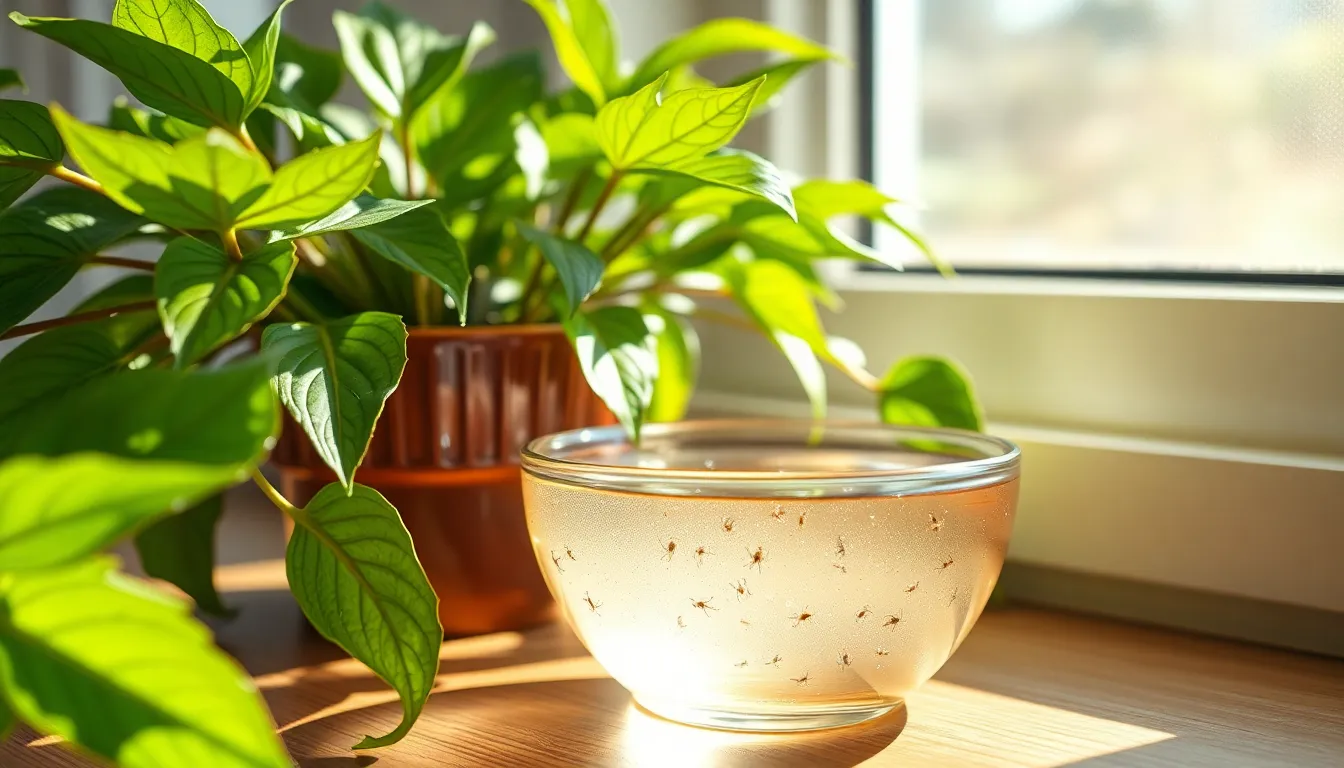
We’ve covered targeting adults and larvae separately, but combining multiple natural methods creates the most effective approach for complete gnat elimination.
Apple Cider Vinegar Trap Setup
Apple cider vinegar traps work by attracting adult gnats with their fermented scent and drowning them in the solution. Fill a small container with apple cider vinegar and add a few drops of dish soap to break the surface tension. Position the trap directly beside your infested plants where gnats are most active.
The acetic acid in apple cider vinegar mimics the smell of rotting organic matter that gnats naturally seek. We recommend using shallow containers like small bowls or jar lids to maximize the trap’s effectiveness. Replace the solution every 3-4 days to maintain its potency and remove captured gnats.
Dish Soap and Water Spray Treatment
Dish soap and water spray provides immediate contact killing of adult gnats while disrupting larvae survival in the soil. Mix a few drops of mild dish soap with water in a spray bottle, creating a solution that breaks down the gnats’ protective waxy coating. Spray the mixture directly on flying gnats and lightly mist the soil surface where larvae develop.
Target both the plant leaves and the top inch of soil during application. The soap solution suffocates adult gnats on contact and creates an inhospitable environment for larvae in the growing medium. We suggest using this treatment in the morning when gnats are most active around your plants.
Combine this spray with your apple cider vinegar traps for maximum impact. The spray handles immediate gnat populations while traps continue working around the clock to catch stragglers.
Use Beneficial Insects to Control Gnat Populations
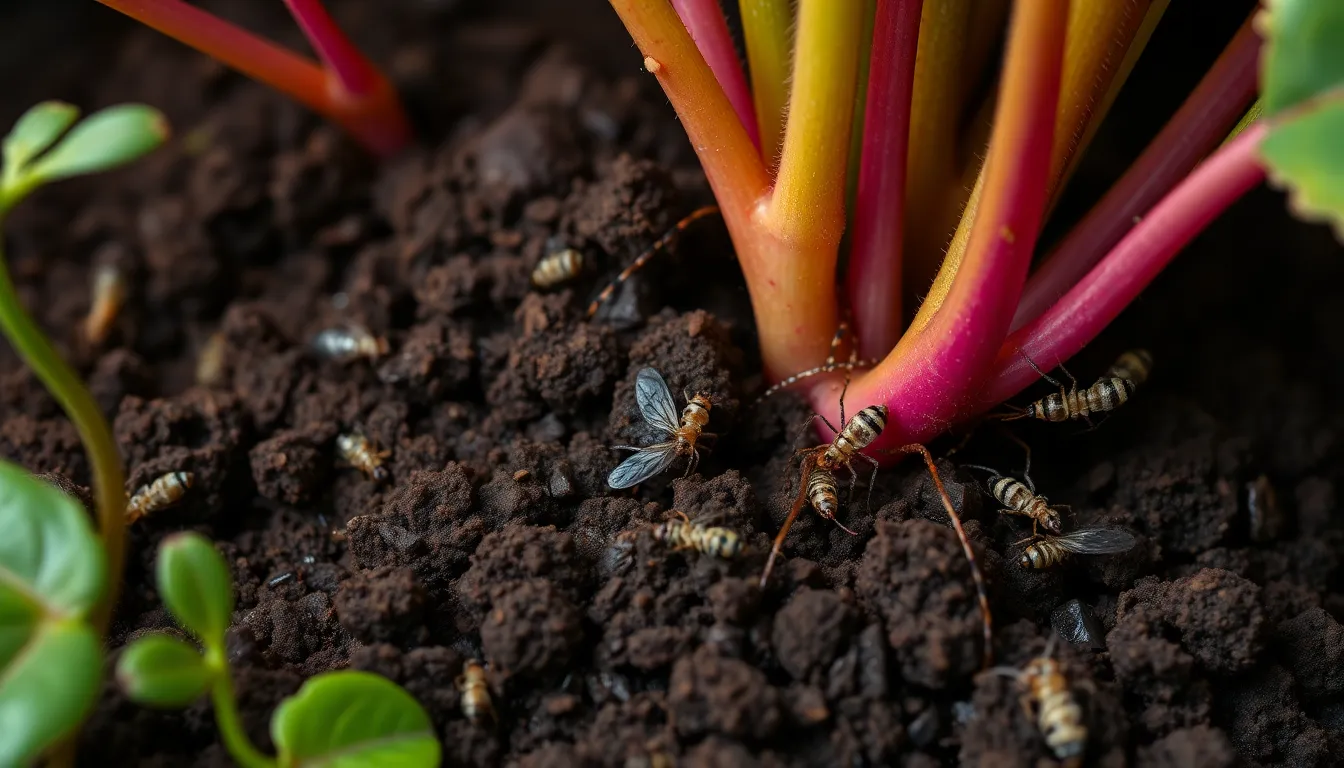
Nature provides us with powerful allies in our fight against fungus gnats. These microscopic warriors target gnat larvae directly in the soil, offering a sustainable solution that doesn’t harm our plants or family.
Introducing Predatory Mites
Predatory mites are tiny insects that feed on fungus gnat larvae living in our potting soil. We can introduce these beneficial creatures directly into the soil where they’ll actively hunt and consume the immature gnat stages. Their presence interrupts the gnat life cycle by eliminating larvae before they can develop into egg-laying adults.
These microscopic predators work continuously in the soil, seeking out their prey and reducing gnat populations naturally. We’ll find them particularly effective because they target the source of our problem rather than just the visible adult gnats. Most garden centers carry predatory mites, or we can order them online for delivery to our home.
Adding Beneficial Nematodes to Soil
Beneficial nematodes are microscopic roundworms that parasitize and kill fungus gnat larvae in our soil. These tiny organisms enter the larvae and release bacteria that are lethal to the pests but completely harmless to our plants and family members. We can apply nematodes by mixing them with water and thoroughly watering our infested plants.
The application process ensures deep penetration into the soil where gnat larvae hide and feed. We’ll need to water the treated soil regularly to keep the nematodes active and effective. Research shows that nematodes can control larvae populations effectively when applied correctly to moist soil conditions.
Multiple applications may be necessary for complete control, but the results are worth the effort. We should follow package instructions carefully since nematodes are living organisms that require proper handling and storage.
Implement Proper Watering Practices
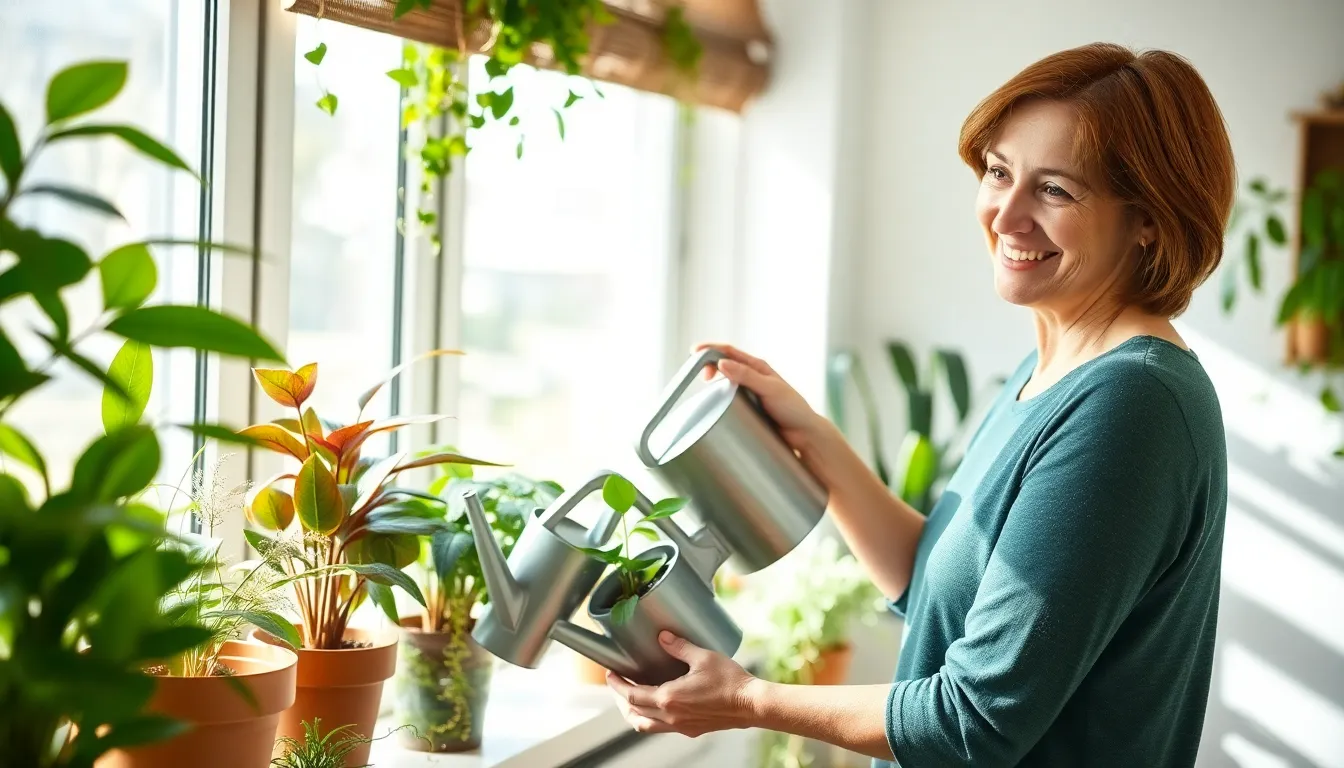
Proper watering practices form the foundation of effective gnat control in houseplants. We’ll focus on two critical aspects that directly impact fungus gnat populations in our indoor gardens.
Checking Soil Moisture Levels
Soil moisture assessment prevents the wet conditions that fungus gnats need to thrive. We should allow the top inch of soil to dry completely between waterings, as this depth represents the primary breeding zone where gnats lay their eggs.
Using a moisture meter provides accurate readings of soil conditions below the surface. We can also test soil moisture by inserting our finger into the potting mix to feel for dampness at the one-inch mark.
Moisture Level Guidelines:
| Soil Depth | Ideal Condition | Watering Action |
|---|---|---|
| 0-1 inch | Completely dry | Safe to water |
| 1-2 inches | Slightly moist | Wait 1-2 days |
| 2+ inches | Wet | Reduce watering frequency |
Checking soil conditions before each watering session eliminates guesswork and prevents overwatering mistakes. We recommend testing multiple spots around the plant’s base since moisture levels can vary within the same pot.
Creating a Consistent Watering Schedule
Consistent watering schedules reduce the continuous moisture that attracts fungus gnats to our houseplants. We need to establish routines that avoid keeping soil perpetually wet, especially during fall and winter months when gnats commonly move indoors.
Overwatering creates the perfect breeding environment for fungus gnats and leads to root decay that these pests find irresistible. We should water less frequently during cooler months when plant growth naturally slows down.
Seasonal Watering Adjustments:
| Season | Watering Frequency | Special Considerations |
|---|---|---|
| Spring/Summer | Every 7-10 days | Monitor for faster drying |
| Fall/Winter | Every 10-14 days | Reduce frequency significantly |
Bottom watering techniques keep the soil surface drier while still providing adequate moisture to plant roots. We place pots in water trays and allow plants to absorb moisture through drainage holes for 30 minutes maximum.
Hydrogen peroxide treatments can supplement our watering routine by eliminating larvae on contact. We mix 1 part 3% hydrogen peroxide with 8 parts water and use this solution occasionally to disrupt gnat development while flushing excess salts from the soil.
Improve Drainage and Air Circulation
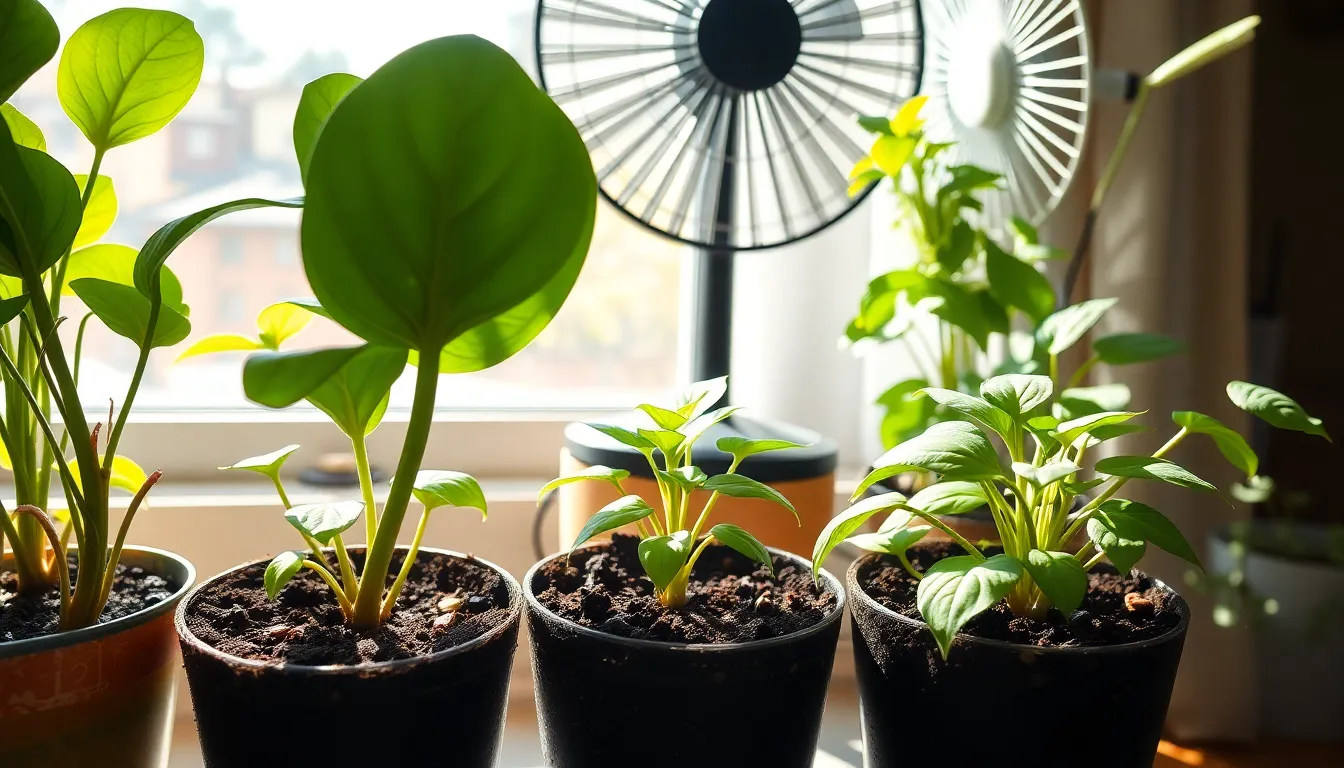
Proper drainage and airflow create an environment that naturally discourages gnat reproduction in your houseplants. These fundamental adjustments target the root cause of gnat infestations by eliminating the damp conditions these pests need to thrive.
Adding Drainage Holes to Pots
Drainage holes serve as the first line of defense against water accumulation that attracts fungus gnats to your plants. We recommend checking every pot in your collection to ensure adequate drainage exists at the bottom.
Creating proper drainage holes prevents water from pooling and keeps soil from remaining soggy for extended periods. Most ceramic and plastic pots need at least three to five holes spaced evenly across the bottom surface.
Drilling additional holes becomes necessary when existing drainage proves insufficient for your plant’s watering needs. Use a drill bit slightly smaller than a pencil width to avoid cracking decorative pots.
Elevating pots on plant stands or saucers allows excess water to escape freely rather than sitting stagnant beneath your plants. This simple adjustment significantly reduces the moisture levels that encourage gnat breeding cycles.
Positioning Plants for Better Airflow
Strategic plant placement enhances natural air circulation and speeds up soil surface drying between waterings. We’ve found that improved airflow disrupts the humid microenvironment where adult gnats prefer to lay their eggs.
Spacing plants several inches apart prevents overcrowding that restricts air movement around each container. Dense groupings create pockets of stagnant air that maintain higher moisture levels in potting soil.
Positioning plants near windows or air vents takes advantage of natural airflow patterns in your home. Good air circulation helps the top layer of soil dry out faster, limiting the moist conditions required for gnat reproduction.
Using small fans to increase airflow provides an effective solution for rooms with naturally poor ventilation. Position oscillating fans to create gentle air movement without directly blasting delicate plant leaves.
Avoiding enclosed spaces like closed cabinets ensures your plants receive adequate ventilation throughout the day. Plants placed in areas with good airflow show dramatically reduced gnat activity compared to those in stagnant environments.
Apply Diatomaceous Earth Treatment
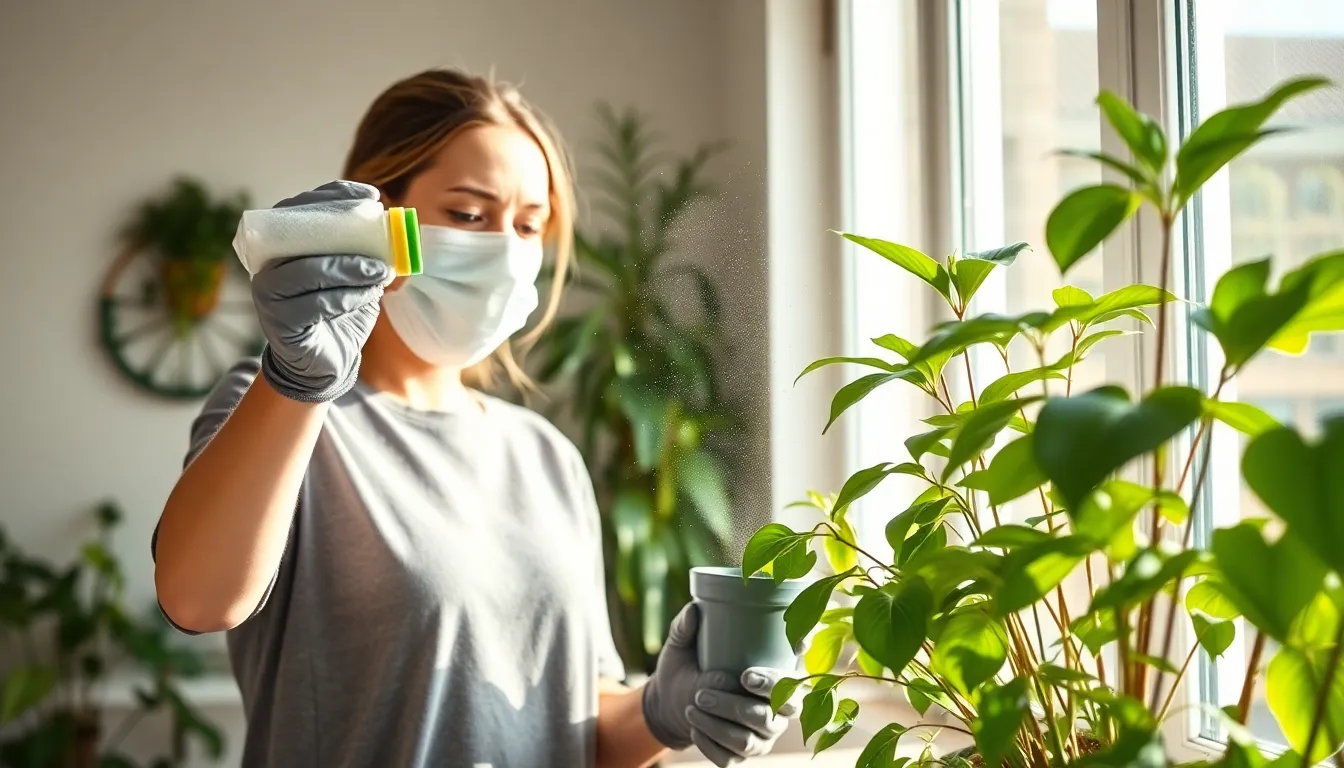
We’ve found diatomaceous earth to be one of the most effective natural treatments for eliminating fungus gnats in houseplants. This powdery substance works by dehydrating and abrading insects while remaining completely safe for plants and families.
Food-Grade Diatomaceous Earth Application
Select food-grade diatomaceous earth from garden centers or online retailers to ensure safety around people and pets. We recommend checking the label carefully since only food-grade DE is appropriate for houseplant treatments.
Ensure your soil isn’t overly wet before application since diatomaceous earth loses its effectiveness when damp. The powder must remain dry to properly abrade and dehydrate gnats and their larvae.
Sprinkle DE lightly across the soil surface of all affected plants, covering the entire exposed potting mix area. We suggest creating an even layer that covers approximately 1/8 inch of the soil surface for maximum effectiveness.
Mix diatomaceous earth into the top soil layer when repotting plants or starting new plantings. This method provides longer-lasting protection since the DE becomes integrated into the growing medium.
Create a barrier around pot bases and rims by dusting DE around these areas to prevent gnats from entering or exiting. We’ve observed this technique particularly effective for preventing gnat migration between plants.
Apply treatment to all affected plants simultaneously to prevent gnats from simply moving to untreated containers. Comprehensive coverage ensures we break the reproduction cycle completely.
Reapply after watering or soil disturbance since diatomaceous earth can wash away or become displaced easily. We typically reapply every 7-10 days or immediately after watering sessions.
Safety Precautions When Using DE
Wear a protective mask during application to avoid inhaling diatomaceous earth dust, especially when treating multiple plants indoors. We always recommend proper respiratory protection in enclosed spaces.
Protect your eyes and nose from direct contact with DE particles by wearing safety glasses and avoiding application on windy days. Gloves provide additional protection for sensitive skin.
Use only food-grade diatomaceous earth products that display clear labeling indicating safety for use around people and pets. We never recommend using pool-grade or industrial DE for houseplant treatments.
Store DE containers in dry, sealed locations away from children and pets when not actively using the product. Proper storage maintains the powder’s effectiveness and prevents accidental exposure.
Monitor pets during and after application to ensure they don’t inhale large amounts of dust, even though food-grade DE is generally safe for animals.
Create Barriers to Prevent Re-Infestation
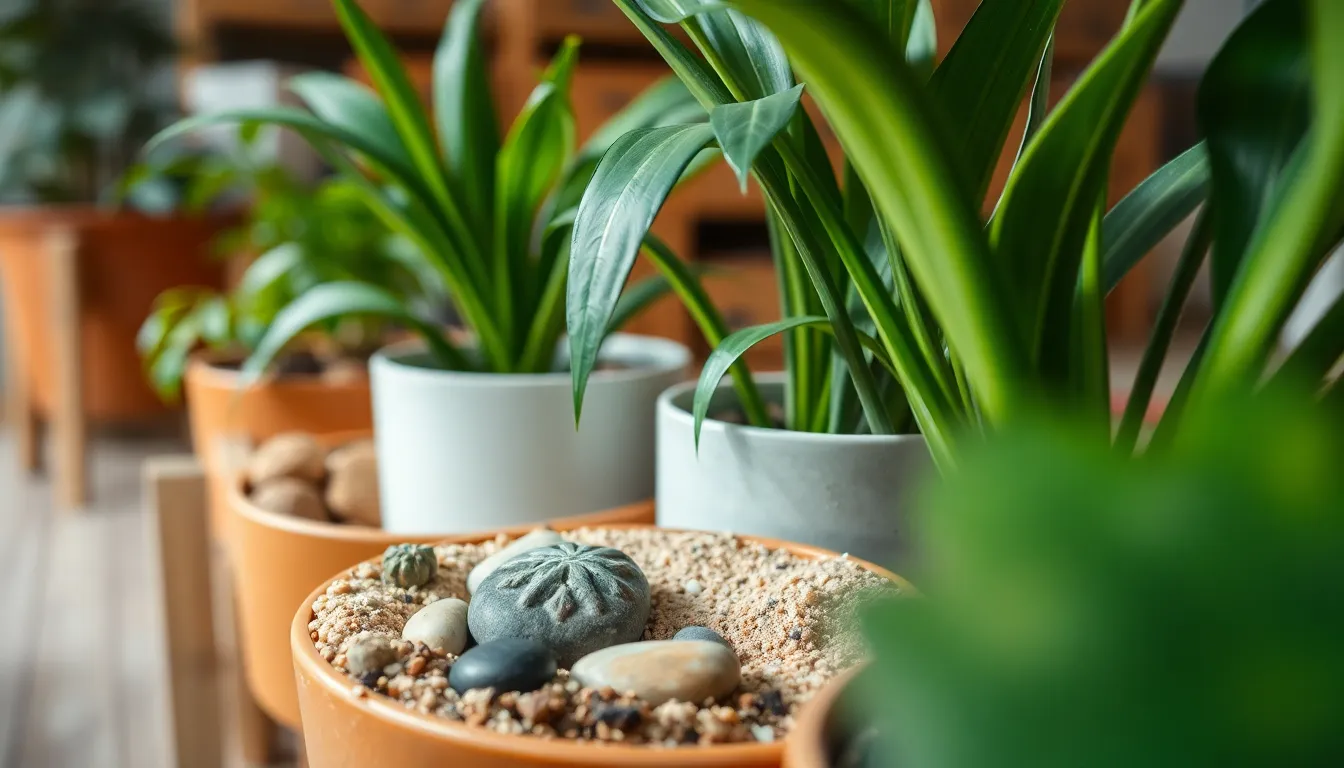
Physical barriers on your soil surface effectively stop adult gnats from laying eggs and break their reproduction cycle. These simple methods create inhospitable conditions that prevent future infestations while maintaining your plants’ health.
Sand Layer Topping Method
Sand creates an effective barrier that prevents adult gnats from accessing the moist soil they need for egg laying. We recommend applying a 1/4 to 1/2 inch thick layer of sand directly on top of your plant soil to interrupt the fungus gnat life cycle.
Benefits of sand barriers include:
- Dries quickly after watering, making conditions unsuitable for larvae development
- Prevents adult gnats from reaching preferred breeding spots in organic matter
- Helps soil dry out faster between waterings
- Creates a coarse texture that gnats find inhospitable
The sand layer works because fungus gnats prefer moist, organic matter for reproduction, and sand provides neither of these conditions. Apply the sand evenly across the entire soil surface, ensuring complete coverage around the plant base.
Decorative Stone Mulch Application
Decorative stones and small pebbles serve as attractive alternatives to sand while providing similar gnat prevention benefits. These barriers limit adult gnat emergence and prevent access to the moist soil surface where eggs are typically laid.
Stone mulch advantages offer:
- Aesthetic appeal that complements your indoor plant display
- Effective moisture regulation at the soil surface
- Durable barrier that doesn’t need frequent replacement
- Prevention of egg laying by blocking soil access
Choose small decorative stones or pebbles that fit your plant containers and room decor. Apply stones in a single layer across the soil surface, creating complete coverage without leaving gaps where gnats might access the soil underneath.
Both barrier methods work best when combined with proper watering practices that allow soil to dry thoroughly between waterings. The key is making your soil surface both inaccessible and unattractive to gnats while managing moisture levels that reduce larvae survival rates.
Monitor and Maintain Gnat-Free House Plants
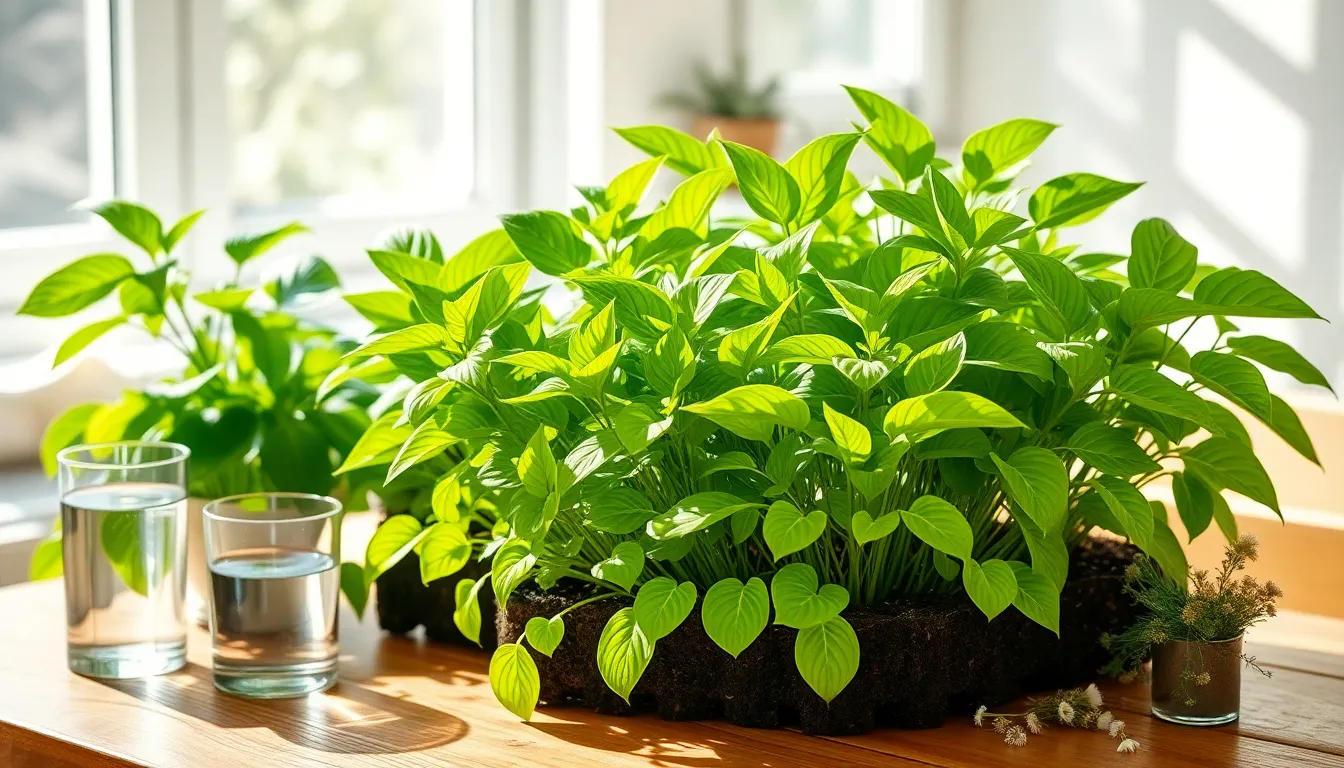
Creating a sustainable gnat control system requires consistent monitoring and proactive maintenance strategies. We’ll establish routines that catch problems early and carry out prevention methods that keep our plants healthy long term.
Regular Plant Inspection Routine
Check new plants thoroughly before purchase by examining soil surfaces for flying gnats and looking for small white or clear larvae with black heads in the potting mix. We should never skip this critical step since introducing infested plants creates widespread problems throughout our collection.
Wash newly purchased plants immediately after bringing them home to remove any bugs or eggs present on leaves and stems. Apply neem oil to leaf surfaces as an additional deterrent against potential infestations before placing plants in our homes.
Isolate new plants for at least one month before mixing them with our existing collection to prevent spreading gnats to healthy plants. This quarantine period allows us to monitor for any pest issues that weren’t immediately visible during our initial inspection.
Monitor soil moisture levels regularly since overwatering creates ideal breeding conditions for gnat larvae. We need to let the top 1 to 2 inches of soil dry completely between waterings to reduce habitat suitability for these pests.
Inspect plant health weekly by checking for signs of declining vigor, yellowing leaves, or unusual wilting that might indicate root damage from gnat larvae feeding activity.
Long-Term Prevention Strategies
Water only when soil feels dry 1 to 2 inches below the surface to avoid creating waterlogged conditions that gnats require for reproduction. We should stick our finger directly into the soil rather than relying on surface appearance alone.
Ensure proper drainage in all containers by using pots with adequate drainage holes and removing standing water from saucers within 30 minutes of watering. Standing water creates perfect breeding grounds for adult gnats to lay their eggs.
Use fresh, high quality potting soil when repotting plants to avoid introducing larvae or eggs that might be present in old or contaminated growing medium. Quality soil also drains better and supports healthier root systems.
Add natural fungicides like cinnamon or chamomile directly to soil surfaces to kill the fungi that gnats feed on, making our potting mix inhospitable to these pests. These natural treatments won’t harm our plants while creating an environment gnats can’t survive in.
Apply BTI products such as Mosquito Bits diluted in water to treat soil and kill larvae without harming plants or pets. Bacillus thuringiensis israelensis specifically targets gnat larvae while remaining completely safe for our families and plant collections.
Space plants adequately to improve air circulation around each container, which speeds soil drying and creates conditions that discourage gnat reproduction. Crowded plants trap moisture and create humid microclimates that these pests prefer.
Conclusion
Getting rid of gnats in houseplants doesn’t have to be overwhelming when you have the right approach. We’ve shown you that combining immediate treatment methods with long-term prevention strategies creates the most effective defense against these persistent pests.
The key to success lies in consistency and patience. Whether you’re using sticky traps diatomaceous earth or beneficial insects each method works best when applied regularly and monitored closely.
Remember that healthy plant care practices form the foundation of gnat prevention. By maintaining proper watering schedules improving drainage and creating good air circulation you’re building an environment where gnats simply can’t thrive.
With these proven techniques you’ll transform your indoor garden into a pest-free sanctuary where both you and your plants can flourish together.
Frequently Asked Questions
What are fungus gnats and why are they harmful to houseplants?
Fungus gnats are tiny flying insects that thrive in moist potting soil and can quickly multiply if not addressed. They harm houseplants by damaging their roots and creating an unpleasant environment. These pests feed on organic matter in soil and can weaken plants, making them more susceptible to diseases and stunted growth.
How can I tell the difference between fungus gnats and fruit flies?
Key differences include size, color, body shape, eye color, preferred location, and flight patterns. Fungus gnats are typically smaller, darker, have elongated bodies, and prefer to hover around soil and plants. Fruit flies are usually lighter colored, have rounder bodies, red eyes, and are attracted to overripe fruit and kitchen areas.
What are the main signs of a fungus gnat infestation?
Signs include adult gnats flying around plants, visible larvae in the soil, declining plant health, sticky yellow traps capturing gnats, and fungal growth on the soil surface. You may also notice small dark flies emerging from the soil when you water your plants or disturb the potting mix.
What’s the most effective way to catch adult fungus gnats?
Yellow sticky traps are the most effective method for catching adult gnats. Place multiple traps directly on the soil surface of heavily infested plants. For budget-friendly options, you can create DIY sticky traps or vinegar traps. Combining sticky traps with soil treatments provides comprehensive gnat control.
How do I eliminate fungus gnat larvae in the soil?
Dry out the soil between waterings and use natural fungicides. Effective techniques include potato slice traps, Bacillus thuringiensis israelensis (BTI) products, and hydrogen peroxide drenches. Bottom watering techniques and soil replacement methods also help manage larvae while maintaining plant health.
Can beneficial insects help control fungus gnat populations?
Yes, predatory mites and beneficial nematodes are excellent natural solutions. Predatory mites feed on gnat larvae in soil, interrupting the gnat life cycle. Beneficial nematodes parasitize and kill larvae when applied correctly. These methods provide sustainable, family-safe approaches to managing gnat infestations.
What watering practices help prevent fungus gnats?
Allow the top inch of soil to dry completely between waterings. Use a moisture meter or finger test to assess soil conditions. Create a consistent watering schedule, especially during fall and winter. Consider bottom watering techniques and occasional hydrogen peroxide treatments to disrupt gnat development.
How can I improve drainage and air circulation to prevent gnats?
Add drainage holes to pots and elevate them to prevent water accumulation. Space plants apart and position them near windows or air vents. Use small fans to increase airflow in poorly ventilated areas. These adjustments help soil dry faster and disrupt the humid conditions gnats prefer.
Is diatomaceous earth safe and effective for fungus gnat control?
Food-grade diatomaceous earth is safe for plants and families while effectively eliminating gnats through dehydration. Apply it to dry soil, create barriers around pot bases, and reapply after watering. Always wear protective gear including a mask and eyewear when handling diatomaceous earth for safety.
What physical barriers can prevent gnat re-infestation?
Apply a layer of sand or decorative stones on the soil surface. Sand dries quickly after watering and prevents egg-laying, while decorative stones offer aesthetic appeal and moisture regulation. Both methods work best when combined with proper watering practices to keep soil unattractive to gnats.
How do I create a long-term gnat prevention system?
Establish a regular plant inspection routine, check new plants before purchase, and isolate them for a month. Monitor soil moisture weekly, water only when soil feels dry, ensure proper drainage, use fresh potting soil, and add natural fungicides to create an environment that’s inhospitable to gnats.

